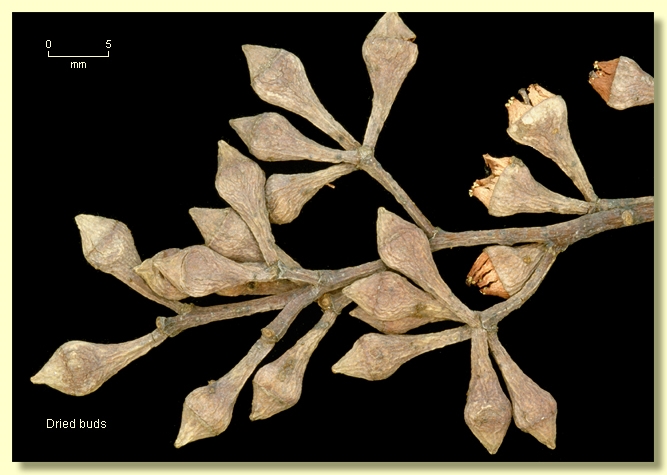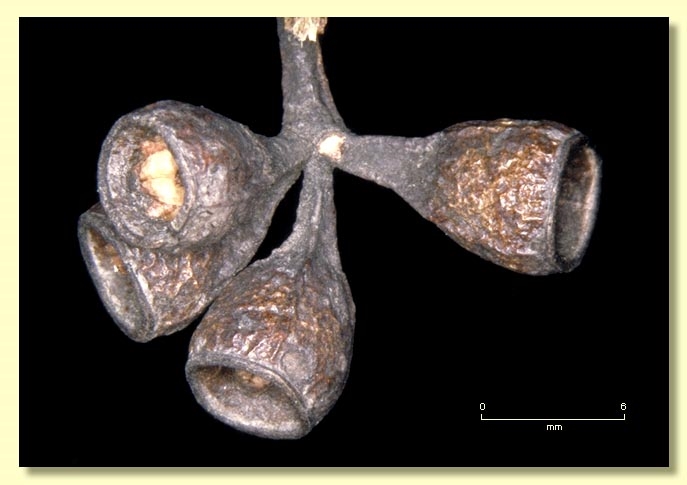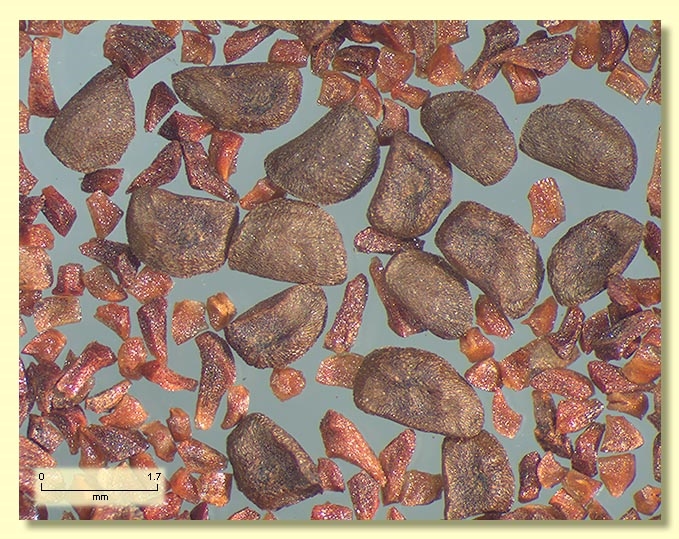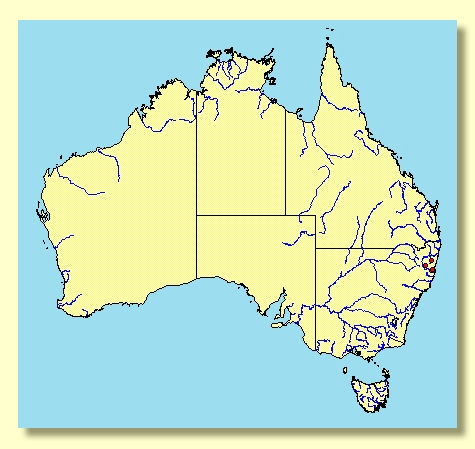Eucalyptus | Symphyomyrtus | Adnataria | Terminales | Rhodoxylon | Discolores
Euclid - Online edition
Eucalyptus ancophila
Grey ironbark throughout or on trunk and larger branches only, smooth bark pale grey.
Juvenile growth (coppice or field seedlings to 50 cm): stems square in cross-section; juvenile leaves petiolate, opposite for 4 to 7 nodes then alternate, ovate becoming lanceolate, discolorous, glossy, green.
Adult leaves alternate, petiolate; blade lanceolate, 9–20 cm long, 1.8–4.8 cm wide, base tapering evenly to petiole, margin entire, slightly discolorous (rarely concolorous), more or less glossy, green, side-veins acute or at greater than 45° to midrib, densely to very densely reticulate, intramarginal vein parallel to and just within margin or well removed from it, oil glands few, mostly intersectional.
Inflorescence terminal compound, peduncles 0.3–1.4 cm long, buds 7 per umbel, pedicels 0.3–0.6 cm long. Mature buds ovoid to diamond-shaped, 0.6–0.7 cm long, 0.3–0.5 cm wide, scar present, operculum beaked to conical, most stamens inflexed but usually a few irregularly flexed, with outer staminodes, anthers adnate, positioned obliquely at filament tip, cuboid, dehiscing by terminal pores, style long, stigma pinhead, locules 3 or 4, the placentae each with 4 vertical ovule rows. Flowers white.
Fruit on pedicels 0.3–0.5 cm long, obconical or barrel-shaped, 0.5–0.8 cm long, 0.5–0.7 cm wide, disc descending, valves 3 or 4, enclosed.
Seeds brown, 1.4–2 mm long, flattened-ovoid or pointed at one end, dorsal surface shallowly reticulate, hilum ventral.
Cultivated seedlings (measured at ca node 10): cotyledons oblong; stems square in cross-section; leaves always petiolate, opposite until nodes 4 to 7 then alternate, ovate to broadly so, 7.5–9.5 cm long, 2.5–5.5 cm wide, base tapering, discolorous, dull, green, becoming distinctly glossy after node 5.
Flowering has been recorded in November.
A medium-sized to tall forest tree known only from the Kempsey–Bellingen districts of north-coastal New South Wales. Eucalyptus ancophila is distinguished by its long slightly discolorous to concolorous glossy green adult leaves, terminal inflorescences, flowers with staminodes and non-ribbed or non-angled fruit.
Eucalyptus ancophila is closest to E. dura, E. corynodes, E. fusiformis, E. melanoleuca and E. tetrapleura. All have relatively broad ovate to broadly lanceolate to lanceolate juvenile leaves. E. dura differs only marginally by having slightly shorter adult leaves and slightly longer fruit. E. corynodes differs by having dull blue-grey to glaucous adult leaves (glossy green in E. ancophila. E. fusiformis differs by having dull concolorous adult leaves and slightly narrower fruit 0.4–0.5 cm wide (E. ancophila with glossy, slightly discolorous adult leaves and fruit 0.5–0.7 cm wide). E. melanoleuca has shorter adult leaves and shorter ovate juvenile leaves. E. tetrapleura has distinctly four-sided buds and fruit.
Eucalyptus suffulgens, E. panda, E. beyeri, E. virens and E. sicilifolia, all members of the same subseries as E. ancophila, differ by having much narrower lanceolate to linear juvenile leaves (ovate in E. ancophila). The other two members of this group, i.e. the two subspecies in E. caleyi, both have dull glaucous adult leaves. E. caleyi subsp. ovendenii differs further by having distinctly four-sided buds and fruit.
Eucalyptus ancophila is sometimes regarded as being closely related to the species in subseries Discolores, in particular E. paniculata. E. paniculata differs marginally by having distinctly discolorous glossy adult leaves (E. ancophila with slightly discolorous to concolorous adult leaves). E. sp. Dorsiventralis differs by having four-sided fruit. E. decolor differs by having distinctly discolorous dull green adult leaves and E. placita differs marginally by having very glossy, distinctly discolorous adult leaves. The adult leaves in E. placita also tend to be slightly shorter than those of E. ancophila (6–12 cm for E. placita and 9–20 cm for E. ancophila).
Within its broad area of occurrence there are other ironbarks which maybe confused with E. ancophila. They are E. crebra, E. fibrosa subsp. fibrosa, E. ophitica and E. siderophloia, all of which differ in having concolorous leaves and buds with stamens all fertile and irregularly flexed. E. crebra can be separated further by having much narrower dull green to grey-green adult leaves. E. fibrosa subsp. fibrosa has buds with a longer conical operculum than that of E. ancophila. E. ophitica has buds with a rounded blunt operculum.
Eucalyptus melanophloia, of more inland distribution than E. ancophila, normally has dull glaucous adult leaves and persistent juvenile leaves in the crown.
Eucalyptus sideroxylon, also of more inland distribution than E. ancophila, differs by having dull adult leaves and buds that hold the outer operculum into maturity and both the inner and outer operculum shed together at anthesis (no operculum scar).
MORE ABOUT IRONBARKS










